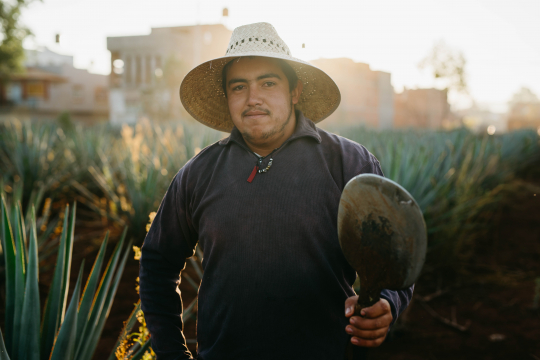Tequila conjures images of lime wedges, salt, and late nights. The popular spirit is deeply connected to the blue agave plants it's made from - and, perhaps surprisingly, to bat populations in Mexico.
Tequila has a designation of origin by which it can only be produced with the blue agave grown in certain regions of Mexico. Tequila's surge in global popularity has driven extensive cultivation of blue agave in Mexico. Most producers of blue agave follow a technique of asexual reproduction by which agave plants are prevented from flowering. Otherwise, all the sugar will go to the nectar in the flowers, and the plant will no longer be useful for producing tequila. This intensive technique of reproduction has been detrimental to agave’s genetic diversity, putting the crop at risk in the long term. Furthermore, the intensive farming practices have removed a key food source from nectar-feeding bats that pollinate agave flowers.
Agave and bats would benefit from agave’s sexual reproduction
Voluntary programs, like the bat friendly program by which tequila (and mezcal) producers can receive a hologram to put in their bottles if they allow agave’s sexual reproduction, have been proposed to increase environmental sustainability and industry resilience. Voluntary systems require consumers to pay higher prices while compensating farmers for the losses that they incur by letting some agave plants flower. Because many farmers only cultivate agave for sale to distilleries and don't produce tequila themselves, conservation initiatives must also directly appeal to this group beyond niche hologram initiatives.
New research used a choice experiment survey to quantify blue agave farmers’ willingness to adopt alternative practices that allow some natural agave flowering and seed production. By focusing our analysis on agave producers, we aim to inform strategies that can balance blue agave genetic diversity, viable farms, and bat populations through industry coordination of consumers, policymakers, and scientists. With adequate financial incentives and training resources, many farmers seem receptive to investing a portion of their crops to benefit bats while increasing agave genetic biodiversity and future viability.
Farmers are interested
On average, farmers said they would allow 93 plants per hectare to flower for unspecified yield increases in the future, 129 plants for a 20% subsidy relative to the investment cost, and 180 plants if the subsidy was 50% of the investment cost. This suggests both environmental benefits and appropriate economic rewards could make "bat-friendly" tequila sustainable.
Collaboration to achieve conservation
Implementing a program to protect the genetic diversity of blue agave will require funding to be implemented. Given the risk that blue agave faces from pests and diseases, and potentially to changes in climate, the tequila industry could take it upon itself to voluntarily fund such a program. Moreover, if tequila consumers are willing to pay a premium for bat-friendly tequila, these additional funds could finance the implementation of a conservation program aimed at agave producers.
There are still risks around changes to key traits that might compromise the protected status of this culturally iconic Mexican spirit. But with cooperation across industry, government, scientists, and conservation groups, tequila production could become an unlikely champion for blue agave plants, nectar-feeding bats, and the farmers whose livelihoods depend on striking a balance between agriculture output and environmental health.

